
At a Glance
- An isolated storm on Sept. 4, slowed harvest productivity for Arkansas rice farmers in Mississippi County.
- The September storm caused lodging for most area farmers on up to half of their 2023 rice acres.
- Despite yield loss and a slowed harvest pace, Ryan Sullivan pointed out the bright spots of a dreary situation.
Rice harvest started earlier than usual this year in the far northeast corner of Arkansas. However, by Sept. 4 the pace went from full speed ahead to a slow crawl. A southern storm, originally forecasted to produce only a half-inch of rain, turned into a downpour of nearly three inches.
Straight-line winds and a swath of heavy rains flattened the remaining rice crop across much of Mississippi County. For most farmers, this meant up to half of their rice acres. Across the county, producers were challenged with harvesting the lodged rice crop.
At the time, local farmer Ryan Sullivan was about two-thirds of the way through rice harvest on his family’s farm. He said, “Our harvest started around Aug. 25 this year. Thankfully, we were able to cut standing rice for about 10 days. Then when that storm came through, the last third of our rice fell flat as a pancake.”
While the weather indeed knocked the crop down, it did not completely dampen spirits. Instead, Sullivan looked on the bright side as he recounted the dreary situation and described the storm as “one little setback.”

The storm impacted some varieties worse than others, but showed no mercy as it flattened most all remaining rice fields – hybrid, non-hybrid, and medium grain. (Photo by: Ryan Sullivan)
Straight-line Winds
In early September, farmers kept an eye on the weather radar in routine fashion, with rain expected in the forecast. Sullivan recalled watching from a mobile app as a storm began to strengthen just south of Memphis, Tenn. He shared radar screenshots of the swath that soon stretched from south of Joiner, Ark., northward to Rector, Mo.
High speed, straight-line winds showed no mercy on the rice crop that took the brunt of the fall. Sullivan said, “Some varieties were impacted worse than others, but the storm laid them all down – hybrids, non-hybrids, medium grains. It didn’t matter what kind of rice it was.”
While the wind blew to his detriment, the direction mattered. Sullivan said a few fields were caught in a crosswind and twisted in different directions, but for the most part, the strong southerly winds laid the rice in one, uniform direction. This was a huge advantage once harvest resumed.
“The efficiency of cutting downed rice is all about how well you can get that rice to feed into the header,” he said. “Whenever the rice lays down flat in one direction, it is a lot easier to pick up with the draper header than if it is all twisted up in different directions.”

Despite yield loss and a slowed harvest pace, Ryan Sullivan pointed out the bright spots of a dreary situation. (Photo by: Ryan Sullivan)
Harvest Prevails
Another bright spot came with the good weather that followed. Fortunately, this was an isolated event and not typical of a tropical storm or hurricane, and the weather stayed dry for the next month.
“It is detrimental to a farmer if a string of rain events comes through after the rice is laid down. Trying to pick up wet straw on the ground with water underneath it is quite a disaster,” Sullivan explained. “Thankfully the weather stayed dry, and we didn’t have to deal with that.”
Rice harvest prevailed, although at a much slower pace. Sullivan said as a rule, downed rice slashes harvest productivity by about 50%. “One combine in one day can cut about half the acres of downed rice compared to standing rice. So, it slowed everybody down,” he said.
It also impacted yield. Rice kernels tend to shatter during a heavy storm event or when the combine header hits the plant. There is also yield loss from the heads of rice lodged in the mud. The overall severity depends on the storm and its impact on individual fields, and a crop insurance policy with a downed rice endorsement helps alleviate the loss.
“There is a definite yield loss, but it is hard to put an exact figure on it. I would suspect it didn’t help the milling quality either. We store 100% of our rice, so we will know more once we haul it out this winter.”
At the time of the interview, the Sullivan family had just wrapped up harvest 2023 for all the rice, soybean, and corn on their farm. Sullivan reported that most area farmers are also finished with grain harvest or close to it, and cotton fields are the majority of what remains to be picked.
“In the end, we had a really good harvest season,” he said. “That one storm was the only big hiccup. After that, we had a good run and have all gotten a lot accomplished in the last couple of weeks.”

Sullivan (pictured with his two sons), produces rice, corn, and soybean alongside his father Mike on their family farm in northeast Arkansas. (Photo by: Catie Sullivan)
Read more about:
HarvestAbout the Author(s)
You May Also Like






